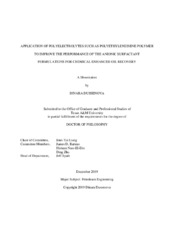| dc.description.abstract | The scope of chemical enhanced oil recovery (CEOR) has extended to the unconventional liquid reservoirs and conventional reservoirs that exist under harsh conditions, such as high temperatures and high brine salinities. The majority of the widely used CEOR surfactants are not stable in such conditions either thermally or chemically. Therefore, most anionic surfactants require a co-surfactant or a co-solvent in order to achieve the aqueous stability, decrease microemulsion viscosity, and match the rock, crude oil and reservoir brine properties at reservoir temperatures. In this proof-of-concept study, we validate the hypothesis that the polyelectrolytes can improve thermal or chemical properties of the widely used anionic surfactants such as alcohol alkoxy sulfate (AAS) and internal olefin sulfonate (IOS) without the need for co-surfactants or cosolvents. This study looked at two types of the polyelectrolyte-surfactant interactions: the polyelectrolyte-surfactant solutions and polyelectrolyte complex nanoparticles (PCN). The hypothesis was validated through a set of experiments or the screening yardsticks designed to monitor and assess the performance and properties of the polyelectrolyte-surfactant solutions and PCN and the corresponding microemulsions with oil at 85 °C. The experiments included the microemulsion phase behavior, aqueous stability, core flood and rheological measurements. Additionally, the rheological data was assessed in more detail to qualify and characterize structures and their stability, molecular weight distribution, concentrations, flowability and pourability of the polyelectrolyte-surfactant solutions, PCN and the microemulsions with oil.
The results of this study showed that polyelectrolyte-surfactant interactions improved the thermal and chemical properties of AAS and IOS surfactants while also improving their surface properties without the addition of a co-surfactant or a co-solvent. In the polyelectrolyte-IOS study, the PCN formed with IOS and the polyelectrolyte protected the IOS surfactant and slowly released it, while ethyl group of the polyelectrolyte increased the surfactant’s aqueous solubility in sodium chloride (NaCl) brine at 85 °C. In polyelectrolyte-AAS study, the polyelectrolyte helped improve the hydrophilicity of the AAS surfactant in NaCl scan with dodecane due to the presence of ethyl group, which also acted as a hydrotrope. Additionally, the polyelectrolyte contained the amine groups, which acted as a high pH buffer (pH 10-11) that helped delay AAS hydrolysis. Lastly, in both cases the total polyelectrolyte concentration was 0.25% or less, and no co-surfactant or a cosolvent was required to improve the surfactants’ performance. The decrease in the number of total components and the total concentration of all the components could potentially result in more cost effective CEOR formulations compared to the ones expected with the addition of co-solvents or co-surfactants. | en |


